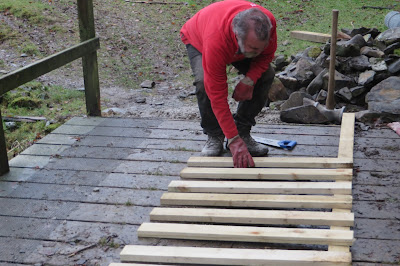We have cleared fallen trees across a footpath, fence and a bridge in this region last week using a long reach pruning saw attachment and a small conventional chain saw.
The upper branches of this fallen tree were blocking one of the Troutbeck footpaths.
The pruning saw at work removing a potentially dangerous split branch.
Much safer!
The small chain saw was used for the lower branches.
The brash was cleared away (to become a habitat for invertebrates) and the footpath is usable once again.
************************************************
The next job was to deal with this uprooted tree that had jammed itself, during recent floods, against the ancient clapper bridge that spans Troutbeck on the track leading to Threshthwaite Cove and Hartsop in the Patterdale Valley.
The pruning saw came into its own by using it to gradually reduce the size of the tree until the main bulk could be dragged 'ashore'.....
..... enabling us to get within reach with the chain saw and reduce it still further into more manageable 'lumps' to be cleared away.
The clapper bridge... minus the tree!
The bridge sustained some damage during the floods. Although it looks to have impressively maintained its structural integrity, one of the slate slabs was flipped over from the immense force of the flood waters.
**************************************************
One more tree to deal with was in the Troutbeck Valley....lower down from the clapper bridge....Here a tree had fallen across a recently fenced off section of Troutbeck. See post...Troutbeck Fencing Project.
Here too the pruning saw proved indispensable.
The chain saw was used for the final lower cuts. The fence is now ready to be repaired by us....When this image was taken it had become very dark and the rain was, yet again, lashing down. The camera flash went off illuminating one of the drops of rain giving it a bright orb effect. (Centre right).




































